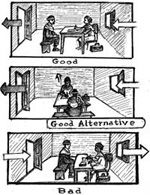17.2.3 Environmental controls
When environmental controls are implemented, managerial activities and administrative controls need to be in place to ensure proper use and maintenance of equipment and the effective training of staff. The most successful approach is to use the administrative and environmental control measures together. Environmental controls aim to reduce the concentration of infectious respiratory particles in the air. The most important steps are outlined below.
Natural ventilation
A simple but effective approach — and one that is not expensive — is to ensure air from areas where there are TB patients is diluted and moved away from areas where there are patients without TB. This you can do by increasing natural ventilation through open windows and doors, as shown in Figure 17.2.

As a healthworker, always try to be upwind of a TB patient — which should ensure that clean air will flow from behind you towards the patient, rather than the other way round.
Ventilation refers to the removal of old, stale or ‘diseased’ air, and replacing it with new, fresh or ‘clean’ air. This has the effect of removing infectious particles, and diluting those that remain, so that the chances of inhaling infectious particles are kept to a minimum. Good ventilation means that air flows from less contaminated to more contaminated areas, not the other way round.
The important point for you is to ensure that at your health facility, doors and windows should be opened, to encourage natural ventilation.
You might ask the question ‘Is mechanical ventilation (air conditioning) better than natural ventilation?’ The problem with mechanical ventilation is that it is costly, needs regular maintenance, a reliable electricity supply and testing which can be especially difficult for developing countries such as Ethiopia. A research study done in Peru, which measured how much of the air within a room is replaced over a period of time, showed that natural ventilation is almost always more effective in maintaining ventilation than mechanical ventilation.
17.2.2 Administrative controls
